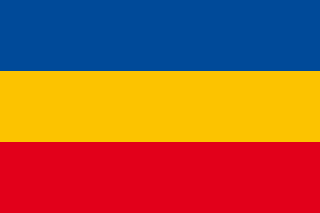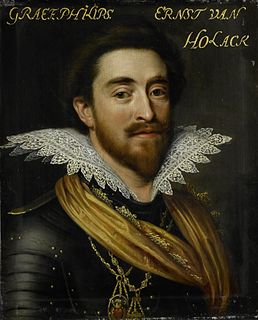
John George of Brandenburg was a prince-elector of the Margraviate of Brandenburg (1571–1598).

1688 (MDCLXXXVIII) was a leap year starting on Thursday of the Gregorian calendar and a leap year starting on Sunday of the Julian calendar, the 1688th year of the Common Era (CE) and Anno Domini (AD) designations, the 688th year of the 2nd millennium, the 88th year of the 17th century, and the 9th year of the 1680s decade. As of the start of 1688, the Gregorian calendar was 10 days ahead of the Julian calendar, which remained in localized use until 1923.

Joseph Joachim was a Hungarian violinist, conductor, composer and teacher who made an international career, based in Hanover and Berlin. A close collaborator of Johannes Brahms, he is widely regarded as one of the most significant violinists of the 19th century.

Joachim von Sandrart was a German Baroque art-historian and painter, active in Amsterdam during the Dutch Golden Age. He is most significant for his collection of biographies of Dutch and German artists the Teutsche Academie, published between 1675 and 1680.

Karel Škréta Šotnovský ze Závořic (1610-1674) was a Czech portrait painter who worked in the Baroque style.

Joachim Anthoniszoon Wtewael was a Dutch Mannerist painter and draughtsman, as well as a highly successful flax merchant, and town councillor of Utrecht. Wtewael was one of the leading Dutch exponents of Northern Mannerism, and his distinctive and attractive style remained largely untouched by the naturalistic developments happening around him, "characterized by masterfully drawn, highly polished figures often set in capricious poses". Wtewael was trained in the style of late 16th-century Haarlem Mannerism and remained essentially faithful to it, despite painting well into the early period of Dutch Golden Age painting.

Albrecht VII, the Handsome, Duke of Mecklenburg in Güstrow, was a minor ruler in North Germany of the 16th century. He also asserted claims to Scandinavian thrones based on the royal lineage of the House of Mecklenburg.

Joachim was, according to Christian tradition, the husband of Saint Anne and the father of Mary, the mother of Jesus. The story of Joachim and Anne first appears in the apocryphal Gospel of James. His feast day is 26 July, a date shared with Saint Anne.
Events from the year 1533 in art.

Mecklenburg-Güstrow was a state of the Holy Roman Empire in Northern Germany, that existed on three occasions ruled by the House of Mecklenburg at Güstrow.

Pieter, Peeter, or Peter Danckerts de Rij, Dankers de Ry, or Peteris Dankersas. was a Dutch Golden Age painter mostly active in the Polish–Lithuanian Commonwealth and Sweden.

Louis Philip was the Count Palatine of Simmern-Kaiserslautern from 1610 until 1655. Philip acted as Administrator of the Palatinate between 1632 and 1648.

Joachim Wilhelm Gauck is a German politician and civil rights activist who served as President of Germany from 2012 to 2017. A former Lutheran pastor, he came to prominence as an anti-communist civil rights activist in East Germany.
Joachim Stegmann Sr.(Potsdam 1595 - Cluj-Napoca 1633) was a German Socinian theologian, Bible translator, mathematician and rector of the Racovian Academy.

Elisabeth of Anhalt-Zerbst was a princess of Anhalt by birth and Electress of Brandenburg by marriage.
Louis II of Nassau-Weilburg was a count of Nassau-Weilburg.

Philip Ernest, Count of Hohenlohe-Langenburg, was Count of Hohenlohe-Langenburg and was the fourth son of Wolfgang, Count of Hohenlohe-Weikersheim (1546–1610), who later became regent of the county of Weikersheim and his wife Magdalena of Nassau-Dillenburg (1547–1643).
Joachim von Burck, also Joachim a Burgk or Joachim Moller was a German composer, notable for an early German Passion setting. As Johann Sebastian Bach's predecessor at the church of St Blasius, he pioneered the musical life in post-Reformation Mühlhausen, bringing it to early fruition. Influenced by the tradition of Flemish polyphony and the Italian madrigal, he developed his own style, focusing clarity of expression. Considering himself a servant to the word of God, he discovered the German language as the foundation of his work, pragmatically addressing the congregation: "for I have aimed to set the words to the music in a manner that almost each syllable has its own note and that the four parts sing the words simultaneously in order that the listener can hear the words clearly." Burck's compositions were widely disseminated and acclaimed for their suitability for common use.

Lelio Brancaccio, Marquess of Montesilvano, was a Neapolitan commander of Habsburg armies in Italy, the Low Countries and Catalonia.
This page is based on this
Wikipedia article Text is available under the
CC BY-SA 4.0 license; additional terms may apply.
Images, videos and audio are available under their respective licenses.














